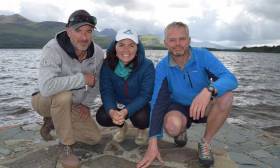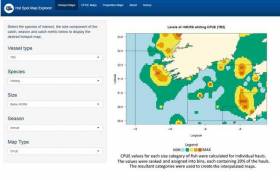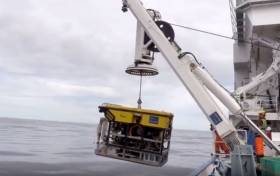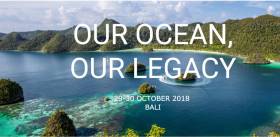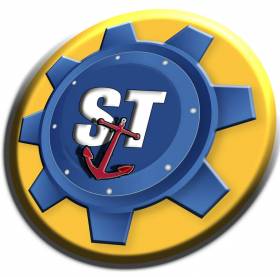Displaying items by tag: marine science
Two centuries after the “white continent” was recorded officially for the first time by an expedition led by Irishman Edward Bransfield, Kerry round-the-world offshore racer Damian Foxall plans to explore Antarctica by sail.
Kerry-born Foxall will be accompanied on his “Team South” expeditions – which are open to the public - by marine biologists Lucy Hunt and Niall McAllister.
As The Irish Independent reports in its Review section today, the three highly accomplished sailors and scientists from Cork and Kerry will take their background in environmental education, research and adventure to head to Antarctica, to experience first-hand the impact of climate change and witness the fragile ecosystem inhabited by penguins, albatrosses, whales and seals.
"I look forward to stepping foot on the continent for the first time"
“Having been involved in over ten round-the-world races, I have seen the southern ocean and the world in a way that few get to experience - icebergs, albatross and forgotten sub-Antarctic islands,” Foxall says.
“ I look forward to stepping foot on the continent for the first time and to sharing this unique privilege with my team and our guests,” he says.
The trio will work with Quixote Expeditions, skippering the 65ft ketch, Ocean Tramp. The Antarctic expedition company has an ethos of community collaboration, education, scientific research and minimal footprint.
When not offshore racing,Foxall is a passionate adventurer and advocate for ocean health, while Niall MacAllister, who runs marine wildlife expeditions and sail training in west Cork, has recently been skippering on the research sailing sloop, Song of the Whale, for a series of marine mammal research programmes.
Lucy Hunt created the ocean health education programme for the Volvo Ocean Race 2017/18 and is now working on the new programme for 2021/22 Ocean Race, while directing her Sea Synergy marine education and awareness centre in her native Waterville, Co Kerry.
The trio has linked in with ornithologist and Antarctic guide Jim Wilson and polar explorer enthusiast Eugene Furlong, who are involved in the project to commemorate Edward Bransfield in his native Ballinacurra, Co Cork, in January 2020.
Team South expeditions start at 9,000 US dollars per person for two weeks, excluding flights. Photographers and film crews are among early bookings, and there is availability on some legs for equally curious citizen scientists and adventurous types, who won’t need much sailing experience.
The five consecutive expeditions start in December and end in March, and the last leg of the journey includes sailing the Antarctic Peninsula before crossing the Drake passage to the Falkland Islands.
A free berth is awarded each trip to a research scientist throughout the southern summer season which runs from November to March. More details are here
Read more about Team South and about Edward Bransfield who put Antarctica on the map in The Irish Independent here
Citizen science pinpointed the first samples of a rare kelp in Irish waters, and now NUI Galway researchers are hoping that sea swimmers, divers and kayakers may help to find more writes Lorna Siggins
Samples of golden kelp (Laminaria ochroleuca), which is normally found in France, Spain and Britain, were identified for the first time almost a year ago in north Mayo.
The small population was discovered in Scots Port cove on the north-west facing Belmullet coastline, and recognised by Dr Kathryn Schoenrock of NUI Galway’s (NUIG) Ryan Institute.
The dominant kelp species found in Irish waters is Cuvie (Laminaria Hyperborea), and five main types of kelp provide important habitats for marine life.
 Photo of sample of golden kelp found for first time last year in Irish waters in north Mayo - NUI Galway researchers appealing to citizen scientists to help locate more examples. Photo: Dr Kathryn Schoenrock, NUI Galway
Photo of sample of golden kelp found for first time last year in Irish waters in north Mayo - NUI Galway researchers appealing to citizen scientists to help locate more examples. Photo: Dr Kathryn Schoenrock, NUI Galway
“Golden kelp, which harbours less biodiversity, is a really important species in Spain and Portugal,” Dr Schoenrock explained.
“We would have expected to find the first samples here on Ireland’s south-east coast, given the proximity to Britain, France and Spain,” she says.
Scots Port is located 1,040 kilometres away from the nearest golden kelp population in Britain, and 1,630 kilometres away from the nearest population in France.
Genetic analyses would suggest that the Co Mayo population is more diverse than the British, resembling the richness described for populations in the Iberian peninsula, Dr Schoenrock said.
“The fact that it was found in a small enclosed cove in north Mayo may be a result of a Portuguese or Spanish vessel sheltering nearby,” she says.
“However, it can drift long distances and it could be more prevalent than we know.”
The samples found by citizen science participants in a Searsearch Ireland and Porcupine survey trip were collected by Dr Stacy A Krueger-Hadfield for genetic analysis at the University of Alabama at Birmingham in North America.
The discovery was the subject of a study which had recently been published in the scientific journal, Marine Biodiversity Records.
Dr Schoenrock said that citizen science initiatives like Seasearch Ireland and Coastwatch are an “excellent way to involve local communities that have a vested interest in the health of these ecosystems”.
“In conjunction with existing research bodies like the Environmental Protection Agency (EPA), National Parks and Wildlife Services, and the Marine Institute, we need more programmes that can sustain long term ecological research of shallow marine systems over many years,” she said.
Seasearch Ireland national co-ordinator Tony O’Callaghan said that its participants had collected over 50,000 records of over 1,000 species.
He said the data set is “the best continuous record collected since the last major state-funded study of Ireland’s inshore marine environment, the Biomar survey, which was in the 90s.”
This project is funded under the EPA Research Programme 2014-2020.
Given that golden kelp has much lower biodiversity than native kelp forests, it is more suitable kelp to harvest, Dr Schoenrock noted.
“It can grow to a larger size and it doesn’t dominate habitats yet in Ireland,” she said.
State approval in November 2017 of a license to harvest native kelp by mechanical means in Bantry Bay has aroused opposition on environmental grounds in West Cork and resulted in ongoing litigation.
Angel shark are in such a perilous state of decline in Irish waters that a group of marine environmentalists has appealed for urgent action by Minister for Fisheries Michael Creed writes Lorna Siggins
Sharks, rays and skates are the most threatened seafish in Europe, and several species of shark caught in Irish waters are on the “red list” of endangered species issued by the International Union for Conservation of Nature (IUCN).
However, the marine scientists say that inaction by the State over the fragile angel shark populations in Kerry’s Tralee Bay and Mayo’s Clew Bay in particular has compounded the situation.
The Irish Elasmobranch Group is a not for profit grouping of scientists and researchers chaired by Dr Kevin Flannery of Dingle, Co Kerry.
It is focused on protecting Ireland’s elasmobranchs – as in sharks, rays, skates and any cartilaginous fishes with five to seven gill openings on each side.
Angel shark - so named because their fins resemble angelic wings- hunt in sandy shallow bays, and have the ability to hide in the sand as they wait for flatfish to eat.
Declining numbers have prompted the scientists to set up a working group, involving the Marine Institute and Inland Fisheries Ireland among others.
The spurdog, porbeagle shark and angel shark are “critically endangered”, while the basking shark is “endangered”, and the shortfin mako, blue shark and hammerhead shark are “vulnerable”
The group has called on Mr Creed to revise legislation to ensure there is no targeted fisheries of any elasmobranchs permitted in Irish waters, either by commercial vessels or by sea anglers.
Last year, a Spanish fishing vessel, Virxen da Blanca (italics) was detained in Irish waters with over 168,000 kilos of “bycatch” shark on board while “ fishing for tuna”.
A special sitting of Clonakilty District Court last September heard the vessel had 164,250kg of blue shark, 98kg of mako shark and 1,250kg of shark fins on board.
Shark fins can fetch a high price in Asia, where they are used in sharkfin soup. The fins are often removed while the shark is still alive and it can then no longer swim effectively and either suffocates or is eaten by other predators.
The scientists say that the maximum permitted “bycatch” of elasmobranch species should be set at 30% of catch onboard, for all EU vessels fishing in Irish waters.
It also says that rays and skates should be excluded from discard regulations on landing all by-catch. Instead, these fish should be returned to sea where their survival rate can be still quite high – unlike many finfish.
The group says Ireland should request that the EU ensure that the shortfin mako shark is listed as a prohibited species. Currently there are no limits to shortfin mako sharks being caught in EU waters and they do not even have to be logged as such.
It has asked Mr Creed to enact “clear and firm legislation for the increased protection of sharks in Irish waters”.
A Department of Agriculture, Fisheries and Food spokesman said Mr Creed supported all five of the group’s recommendations, but believed that a bycatch of all of these species should be “considerably lower” than the 30 per cent proposed.
The group did not make “any specific proposal” relating to the angel shark, but Mr Creed would be happy to consider same in consultation with the National Parks and Wildlife Service, the spokesman said.
The department said that both it and the Marine Institute are working on “ways to improve the protection of the critically endangered angel shark in Irish waters”, and Ireland recently supported a proposal from the Government of Monaco that angel shark be included in annexes I and II of the Convention on the Conservation of Migratory Species.
This “provides a framework to enhance protection for this migratory species”, it said.
Valentia Island Aims to Lead Way in Hydrogen Energy Use
#islandnews - An island off Co. Kerry is aiming to produce clean energy which could be used to power public lighting and propel its ferry service, among other uses.
As the Irish Examiner writes, Valentia Island is planning to transform its energy needs through a potential hydrogen-based product.
The project which is community-led is based on a successful venture which has been continuing and developing on Scotland’s Orkney Islands since 2016.
Details of the proposed energy model will be outlined tomorrow in The Royal Hotel Valentia Function Room on the island in south Kerry.
The ultimate goal is to power the island, said Colum O’Connell, chairman of the Valentia Energy Group.
He said islanders would be able to pull up at hydrogen refuelling stations just as Orkney islanders currently do. Mr O’Connell said in the not-too-distant future Valentia could eventually be a powerhouse for storing and selling on the clean energy.
More on the story can be read here.
Marine Institute New "App" For EU's Fish Discard Ban
Eight years after British celebrity chef Hugh Fearnley-Whittingstall campaigned to end the EU’s wasteful practice of encouraging skippers to dump unwanted fish at sea, a new Marine Institute “app” aims to make life easier for Irish fishing vessels writes Lorna Siggins.
The mapping application to avoid discard “hotspots“ can be used by skippers working mixed fisheries, particularly in Irish and British grounds, who face a virtually impossible task due to the richly diverse nature of marine life.
The “app” draws on data to identify sea areas where they are more likely to catch unwanted fish which cut short the length of their fishing trip.
It was the EU’s own labyrinthine Common Fisheries Policy which had forced skippers to take measures like dumping unwanted species or undersized fish at sea – prompting one French skipper to observe that EU fish policy was designed as if the Atlantic was as simple as an “aquarium plugged into a computer”.
Irish industry organisations point out they had pioneered the development of selective gear technology long before Mr Fearnley-Whittingstall’s “Fish Fight” campaign of 2011 made headlines. However, there is no fishing gear yet developed which is so selective that it can retain only targeted species.
Recognising this, the Marine Institute “app” identifies grounds with consistently high catch rates of juvenile fish and “choke” species – as in the first species to hit the quota limit, which then effectively halts all further fishing.
Skippers using the “app” have the option of avoiding these areas, making the best use of selective gear technology, the Marine Institute says.
The Marine Institute researchers used observer data collected from Irish, British and French vessels in the Celtic Sea, and developed mapping techniques to identify consistent patterns in catches on Irish grounds.
The interactive technology on the “app” includes individual maps per species, which can be viewed based on vessel category, season, and size of the catch.
“While much of the information contained within these maps will be familiar to those regularly fishing in these areas... this tool could act as an additional resource .. in avoiding unwanted catches through spatial avoidance,” Julia Calderwood and Dave Reid of the Marine Institute say.
The first phase of what the EU describes as the “landing obligation” came into effect on January 1st, 2015, for pelagic – mackerel, herring and blue whiting – fisheries. The discard ban applied to all quota species from January 2019.
The institute, based in Galway, has been working with partners from 12 countries to develop strategies for the gradual elimination of discards as part of a project called “DiscardLess”, funded by the EU’s Horizon 2020 programme.
The Irish Fish Producers’ Organisation (IFPO) said it welcomed any initiative which would assist Irish vessels, given the degree of concern around the implementation of the discard ban. The IFPO plans to hold several workshops on the issue with vessel owners in co-operation with the State’s Sea Fisheries Protection Authority (SFPA).
Skippers using the “app” have been asked by the Marine Institute to provide feedback which may help to improve it through a short online questionnaire here
SeaMonitor Project Uses Marine Species Tracking Technology
A unique marine research project, the first of its kind in Europe, studying the seas around Ireland, Western Scotland and Northern Ireland was launched this week in Derry–Londonderry. The SeaMonitor project is led by the Loughs Agency and supported by another eight leading marine research institutions using innovative marine species tracking technology to better understand and protect vulnerable marine life in our oceans.
Funding for the SeaMonitor project has been provided by the EU’s INTERREG VA Programme (Environment Theme), which is managed by the Special EU Programmes Body (SEUPB), to the tune of €4.6m. Match-funding for this project has been provided by the Department for Agriculture, Environment and Rural Affairs in Northern Ireland and the Department of Housing, Planning and Local Government in Ireland. This substantial investment will extend the existing network of ‘smart’ buoys and oceanographic models – delivered by sister projects COMPASS and MarPAMM – so that a line of acoustic receivers runs between the island of Ireland and Scotland.
The SeaMonitor project will deliver Europe’s largest telemetric marine array and spatial models supporting the conservation of basking shark, cetaceans, salmon, seals and skate. It will also provide three Management Plans; one for skate in the area from Loch Sunart to the Sound of Jura and two for salmon in both the River Foyle and Clyde estuaries.
Loughs Agency Designated Officer, Sharon McMahon, explained: “For over twenty-one years, the Loughs Agency has been at the forefront of protection and conservation of our local waters and aquaculture. So we are really excited to be leading the way alongside expert colleagues from statutory and academic institutions and a range of stakeholders that will ultimately produce dynamic management plans for some of our most important and vulnerable species”.
Welcoming the project Gina McIntyre, CEO of the Special EU Programmes Body, said; “The maritime territory across Europe is at risk from multiple challenges and must be protected for future generations of citizens. This tri-regional project will help to safeguard our precious shared marine environment by providing much-needed management and conservation work that will protect priority species and habitats, across Ireland, Northern Ireland and Western Scotland.”
John Speers, Marine and Fisheries Director at the Department of Agriculture, Environment and Rural Affairs in Northern Ireland, said “I am pleased to support the SeaMonitor project, which will use the best available technology to track some of our most important marine species. These animals spend the most of their lives hidden from view and are only occasionally seen at the surface, making monitoring them very challenging. The SeaMonitor project will help us better understand their life cycles and improve protection of these important marine species.”
#coastalnotes - As part of the RDS Library Speaker Series will be a presentation ‘Snapshots and Science - The Shallow Seas of Ireland’ which is to be held next Wednesday March 13 between 18:30-20:00.
The presentation by leading underwater photographer Paul Kay will feature an exploration of Ireland’s rich underwater world, one which is hidden from most of us and one which is still being explored.
It will showcase some extraordinarily beautiful species and locations and will also illustrate just how little we know and understand about the seas and how we utilise them. In an information rich era it will no doubt surprise many to see what lies below the waves.
The event held in the RDS, Ballsbridge, Dublin 4, is free of charge and open to all, but online booking is required. To book click here.
A team of marine scientists have discovered a very rare shark nursery, 200 miles west of Ireland while investigating Ireland’s deep ocean territory. The announcement was made at the INFOMAR Seabed Mapping Seminar in Kinsale today, where video highlights were debuted of this rare occurrence, discovered during the recent “SeaRover” survey by the Marine Institute’s remotely operated vehicle (ROV) Holland 1 deployed onboard the ILV Granuaile. The INFOMAR Programme is a Government of Ireland initiative, funded by Department of Communications, Climate Action and Environment and is a deliverable under Project 2040, Ireland’s National Development Plan.
Speaking at the event David O’Sullivan, of INFOMAR and Chief Scientist on the SeaRover survey (Sensitive Ecosystem Analysis and ROV Exploration of Reef habitat) said: ‘We are delighted to report the discovery of a rare shark nursery on a scale not previously documented in Irish waters. This discovery shows the significance of documenting sensitive marine habitats, and will give us a better understanding of the biology of these beautiful animals and their ecosystem function in Ireland’s Biologically Sensitive Area.”
During the SeaRover survey undertaken last July, the shark nursery was discovered while exploring Ireland’s deep-water coral reef systems. The exploration initiative was a collaboration jointly funded by the Irish Government (DAFM & DCHG) and the EU’s European Maritime and Fisheries Fund, supported by Marine Institute, NPWS, Geological Survey Ireland, & NUIGalway.
Speaking at the INFOMAR Seminar, Koen Verbruggen, GSI Director said “We are delighted that this discovery has been unveiled at todays’ event, demonstrating the importance of mapping our seabed habitats in understanding and managing our vast and valued ocean resources. Our data and team continue to make significant contributions to harnessing our ocean wealth.”
Very large numbers of egg cases, commonly called mermaids purses, were filmed on the seafloor at depths reaching 750 m. Such large concentrations of egg cases, are rarely recorded and indicate females may gather in this particular area on the seafloor to lay their eggs.
A large school of Blackmouth catshark (Galeus melastomus), abundant in the northeast Atlantic were present at the site, and it is likely the eggs are of this species. A second more unusual and solitary species, the Sailfin roughshark (Oxynotus paradoxus) was also observed. “Both species are of scientific interest as Ireland has an obligation to monitor deepwater sharks under the Marine Strategy Framework Directive”, said Maurice Clarke from the Fisheries Ecosystem Advisory Services at the Marine Institute.
The Sailfin roughshark is listed as ‘Near Threatened’ by the International Union for Conservation of Nature meaning it may be considered threatened with extinction in the near future. The species grows up to a length of 1.2 m and is usually observed moving slowly with deep water currents feeding on small benthic invertebrates. The individual may have been feeding on the eggs although this was not observed by the science team.
“No pups were obvious at the site and it is believed that the adult sharks might be utilising degraded coral reef and exposed carbonate rock on which to lay their eggs. A healthy coral reef in the vicinity, may act as a refuge for the juvenile shark pups once they hatch. It is anticipated that further study of the site will answer some important scientific questions on the biology and ecology of deep water sharks in Irish waters,” explained David O’Sullivan.
The shark nursery was observed within one of six offshore Special Areas of Conservation (SACs) in Irish waters designated under the EU Habitats Directive for Annex 1 reefs. The SACs host a diverse range of marine animals including sea fans, sponges, worms, starfish, crustaceans and a variety of fish species. Many of these species were apparent in the newly discovered nursery highlighting the importance of conserving key areas of our oceans to sustain and support marine biodiversity.
“Our key objective is to assess, protect and monitor Ireland’s rich offshore marine biodiversity so we can begin to manage our marine resources effectively. Without knowledge of what lives in our seas we are at risk of never fully understanding and appreciating Ireland’s marine environment”, Dr Yvonne Leahy (NPWS) explained.
Scientific expertise and the high resolution deep sea mapping dataset used in survey planning and design was provided by the national seabed mapping programme INFOMAR. This enabled targeting potential locations of reef habitat for this survey, in the form of seabed features including submarine canyons and seabed mounds, frequently host to cold water coral reefs and associated habitats in Ireland’s rich offshore waters.
The survey called ‘SeaRover’ is the second of three surveys commissioned and jointly funded by the Irish Government and the EU’s European Maritime and Fisheries Fund. ‘The cross-government initiative is supported by the Department of Agriculture, Food and Marine (DAFM), Department of Culture, Heritage and Gaeltacht (DCHG), and Department of Communications, Climate Action and Environment as part of the Marine Institute’s implementation of the Marine Biodiversity scheme. Survey operations were coordinated and led by the INFOMAR programme which is a joint venture between the Geological Survey Ireland and the Marine Institute, funded by the Department of Communications, Climate Action and Environment. Scientists from the Marine Institute, National Parks and Wildlife Service, National University of Ireland, Galway, Plymouth University and Aquafact participated in the survey which this year extended coverage to include Ireland’s farthest offshore area within its Exclusive Economic Zone at the Rockall Bank.
Minister Creed Addresses Ocean Leaders at Our Ocean Conference
Minister Creed today attended the international Our Ocean Conference in Nusa Dua, Bali. This is the fifth of these conferences, started by former US Secretary of State, John Kerry, which brings together global community representatives and urges them to commit to tangible actions to ensure the future sustainability of the world’s oceans, and since 2014, the conference has produced commitments totalling in the region of US$18 billion.
In speaking during the panel discussion on Climate Change, Minister Creed outlined Ireland’s continued commitment to addressing the challenges raised by climate change stating that “the requirement to address knowledge gaps in relation to climate impacts within the marine/coastal environment have been identified as a prospective priority research area to enhance Ireland’s climate resilience”.
Minister Creed highlighted the provision of €10m to the local authority sector in Ireland to aid in the establishment of four Climate Action Regional Offices (CAROs), the continued commitment to the Environmental Educational module of Ireland’s Green Schools programme, continued support of the Clean Coast Programme and the provision of €1mil over a five year period (2019-2024) towards a new programme of Ocean & Climate research in an Irish Higher Education Institution.
Other commitments announced by Ireland included the completion of a €250 million naval vessel replacement programme involving the purchase of four larger more capable offshore patrol vessels tasked primarily with maritime surveillance and fishery protection, and Ireland’s commitment of €32 million for the delivery of three Pilatus 12 aircraft to the Irish Defence Forces in 2019/20.
Alongside the conference, Minister Creed attended a lunch, hosted by President of Indonesia Joko Widodo; met with the EU Commissioner Vella; met Irish attendees at the Our Ocean Youth Summit and met with the USA delegation to the conference to discuss the work of the Atlantic Ocean Research Alliance (AORA).
A scientific experiment, conducted by SEA-Tech a Cork based SME, under the control of a group of reputable witnesses composed of maritime professionals and researchers is set to enter the record books. The purpose of the experiment was to set a world record for the furthest maritime broadband transmission without satellite or cellular network using SeaFi wireless maritime communication system. Academic staff from Cork Institute of Technology (CIT) and The National Maritime College of Ireland (NMCI) and University College Dublin (UCD) were actively involved as reputable expert witnesses.
Dr Sean McSweeney, Lecturer in the Department of Computer Science in CIT and Sean O’Callaghan (NMCI), were tasked to conduct a thorough inspection at Roches Point Lighthouse SeaFi coastal station. Their experience, both as lecturer and system administrator, helped in establishing the fact that the lighthouse and the ship that would take part in the experiment were not connected to each other with any other system but a wireless radio link. Immediately after the inspection, the lighthouse was closed and keys kept by the Commissioners of Irish Lights when Prof Frederic Dias (Mathematician UCD) witnessing the operations in Roches Point Lighthouse, would take up position in the lighthouse with SeaFi coastal operator Theophile Buyssens from France. Prof Frederic Dias’ role consisted of calculating distance in real-time between stations.
Karle Grabe, Lecturer in the Department of Computer Science in CIT, and Capt Bill Kavanagh from NMCI, inspected SeaFi ship station on board OSV Ocean Spey in Ringaskiddy Deep Water Berth prior to departure. Their expertise in ICT and Nautical Science combined together guaranteed the results. Bill Kavanagh is a former sea captain (Emerald Isle Marine), nautical instructor and Head of Regional Fisheries, needless to say a well-seasoned seaman who knows his way around a ship. Assisting Karl Grab, a software development expert and a yachting enthusiast, both men inspected the bridge and the mast of the ship in search for any trace of connectivity other than SeaFi radio link before leaving the ship under the watchful eye of CIT graduate, Capt Mark Sloan and Chief Officer James Darwin.
SeaFi facilitates the creation of private telecommunication networks in ports and coastal areas by establishing the connection between lighthouses, maritime wind turbines, or offshore drilling platforms and vessels at sea. These networks are used to connect the ships and their crews, as well as the data collection buoys (weather, tides...) for example. SeaFI is a radio system on the frequency band of 2.4 GigaHertz which works a little like Marconi's telegraph system, using coastal stations (connection points) and embarked stations at sea. The key to the system is a bespoke ship antenna, which transmits wirelessly, and securely, over a private wireless network to special receiving shore antennas, one of which is attached to the Roche’s Point lighthouse “to put it simply, WiFi is more like a bare light bulb while SeaFi is more like a focused flashlight” says SEA-Tech.
The SeaFi ship station operator was Arnaud Disant, Marine Data Communications lecturer in NMCI and Marine ICT Engineer working with Port of Cork, Port of Waterford and Rosslare Europort. For the past decade, Arnaud Disant has been involved into the development of SeaFi working with maritime professionals, pilots and the Irish Naval Service.
Four bells in the afternoon watch, the ship left port at 14.00hrs. Expert witnesses from CIT, NMCI and UCD were in contact by email with the ship station operator. For several hours the Offshore Supply Vessel, owned by Mainport, had set course south of Roches Point Lighthouse in Cork Harbour. Every 15 minutes both operators in Roches Point, and on the bridge, kept running tests such as sending emails to the expert witnesses and making Skype calls. Emails leave traces when sent, expert witnesses Sean O’Callaghan, Carl Grabe and Dr Sean McSweeney would also confirm the emails originated from SeaFi ship station. Each email sent to shore, from the ship, was delivered without satellite or cellular connection. Once designed to guide ships into ports, lighthouses could be refitted to enter the digital era of marine big data.
At exactly 16:31hrs Roches Point issued one last message to the ship station, at 16:32hrs SeaFi ship station (code name Gemini) had gone silent after two and a half hours on uninterrupted transmission. OSV Ocean Spey was spotted on INS vessel LÉ James Joyce patrolling south west of Ocean Spey position. Prof Frederic Dias posted on Twitter the results of his calculation and was immediately echoed by expert witness, Lt Commander Brett, Commanding Officer of LÉ James Joyce reporting the position of Ocean Spey at Lat 51 30.05N Long 008 03.70W – 19.4 nautical miles from Roches Point (35.9 kilometres) at the time the last transmission was made. Evidence of the record has been sent to the Guinness World Book of Records for homologation.
The submission was supported by each individual independent expert witness.
Arnaud Disant, the engineer who invented SeaFi said: “SeaFi could put Ireland on the forefront of modern maritime technology.”It’s no doubt, this episode will be followed by many others, SeaFi is already attracting curiosity in The Netherlands, France, Italy, US and from as far away as Chile. Beyond the achievement itself, for an island nation, it’s a vivid example of academic staff teaming up actively together to support the research of a local SME.


























